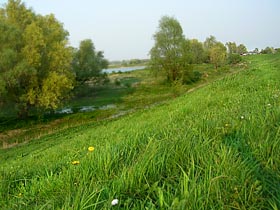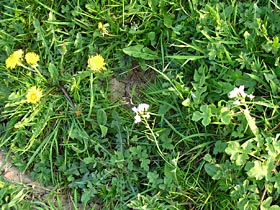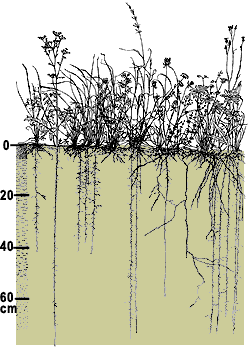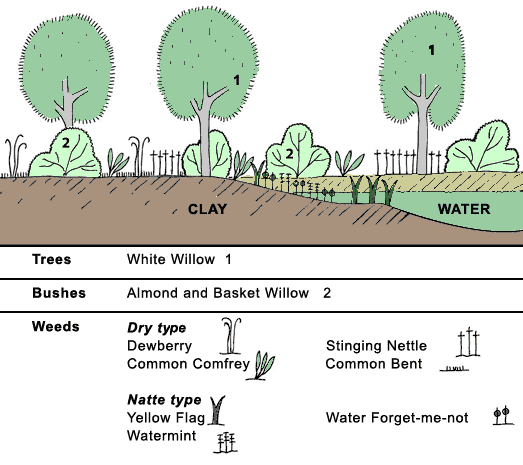Overview of characteristic plant species in the Ooijpolder
Quite a number of biotopes are found in the Ooijpolder: dikes, road shoulders, river banks, agricultural ground, ponds due to dike breaches and submerged clay pits, gravel and sand dredging areas and swamps. Some of the plant species characteristic for a particular biotope, i.e. the grasslands and the wetlands in the "De Groenlanden", are listed in a table (as
excel and as a
pdf document, in Dutch, with families and references to pages of Heukels flora). These species can be further studied through a separate webpage with an
overview of plant species providing hyperlinks to descriptions and photographs of each plant.
Vegetation on dike slopes and road shoulders
The dikes along the big Dutch rivers are built from the local soil, preferably clay, but also sablon and sand. Due to their steep slope and their protective function against water these dikes are not most appropriate for agriculture. Thus, they belong to the less intensively cultured grasslands, being mostly pasture meadows. Factors like (over)fertilization and sowing of culture weeds (in particular Perennial and Italian Ryegrass, respectively
Lolium perenne and
Lolium multiflorum), which in other grasslands have caused loss of variety, have been postponed here. The greatest threatening for flora and fauna is (was?) the reinforcement and re-elevation of the dikes. This reconstruction has been conducted everywhere, in a number of dike segments in such a way that the old beauty could be preserved, and nature can recover.
Ungrazed meadows on dike slopes

The roots of a well-developed weed meadow have a stabilizing effect on the dike. Besides a dense rooting layers close to the surface, roots of some weeds and grasses reach up to about 75 cm depth (see figure here below). When they are not treated with fertilizers and mowing does not occur too early in the year, not before June, they form the most beautiful examples of flower-rich grasslands.
Grazed grasslands on dike slopes

In grazed grasslands on dike slopes and other places the vegetation is kept short by the cattle (cows and sheep) so that flowering and seed setting are often impeded. The timing of mowing is important because some species are dependent of seeds for reproduction. This is valid for a number of annuals (examples: Black Medick,
Medicago lupulina and Lesser Trefoil,
Trifolium dubium) and for perennials (mostly bi-annuals) monocarp plants (those die after flowering once, examples: Tansy Ragwort (
Senecio jacobea, Rough Hawk's-beard (
Crepis biennis, Wild Carrot (
Daucus carota and Greater Burnet-saxifrage
Pimpinella major). Tansy Ragwort has been lately discredited because this species -and other Ragworts occuring in the Netherlands- are toxic for some mammals and because the population of this plant increases. (Read more on the
scientific facts, but also about stories around Tansy Ragwort).
Besides there are plants that do not support well trampling by livestock (example, nonewithstanding its suggestive name: Cow Parsley
Anthriscus sylvestris).
Meadow community on the dikes of the Ooijpolder
The plant community encountered on the dikes of the Ooijpolder can be considered to belong to the mesophyllic hay meadows (
Arrhenatherion elatioris). These occur on substrates varying from sandy to clay-rich, which always corresponds to moderately to rather fertile soils. Also the need for humidity can vary from quite dry to wet. Therefore this community is said to have a relatively broad amplitude. False Oat-grass (
Arrhenatherum elatius) one of the dominating species in this typical meadow grass landscape (see figure) with a rather high variety of species (30-40 different species on the best locations).
| Typical distribution in Arrhenatherion elatioris meadows. |
 |
| Schematic profile of most common species in , from left to right: False Oat-grass, Wild Parsnip, Smooth Meadow-grass, False Oat-grass, Bush Vetch, flowering False Oat-grass, Wild Parsnip, Carrot, Hedge Bedstraw, Meadow Cranesbill, Rough Hawk's-beard. According to Hundt, 1958. |
Thanks to the great variety in species, these meadows are colorful; a pleasure for our eye, but moreover a habitat for insects living on flowers.
- Grasses (Poaceae) frequently occuring in these meadows are: False Oat-grass (Arrhenatherum elatius), Cocksfoot
(Dactylis glomerata), Red Fescue
(Festuca rubra), Meadow Foxtail (Alopecurus pratensis), Yellow Oat-grass (Trisetum flavescens), Meadow Fescue (Festuca pratensis), Rough Meadow-grass(Poa trivialis), Sweet Vernal Grass (Anthoxanthum odoratum) and Crested dog's-tail (Cynosurus cristatus).
- The Leguminosae or Fabaceae are well represented in these meadows and contribute to the colors purple, yellow, white and lila: Tufted Vetch (Vicia cracca), Bush Vetch (Vicia sepium), Meadow Vetchling (Lathyrus pratensis), White Clover(Trifolium repens), Hare's-foot Clover(Trifolium arvense) and Lesser trefoil (Trifolium dubium).
- To the palette are added the white, grayish, and yellowish colors of the Apiaceae or Umbelliferae: Cow Parsley (Anthriscus sylvestris), Hogweed(Heracleum sphondylium), Caraway (Carum carvi), Wild Parsnip (Pastinacia sativa), Wild Carrot (Daucus carota) and Greater Burnet-saxifrage (Pimpinella major).
- To the flower bouquet are furthermore contributing the yellows, yellow and white, red-purple colors of the Composites (Asteraceae): Oxeye Daisy (Leucanthemum vulgare), Brown knapweed (Centaurea jacea), Greater knapweed (Centaurea scabiosa), Tansy Ragwort (Senecio jacobea) and Rough Hawk's-beard (Crepis biennis).
- from diverse families are coming the yellow of Meadow Buttercup (Ranunculus acris), the red of Common Sorrel (Rumex acetosa), the white of Hedge Bedstraw (Galium mollugo), the greenish/grayish hues of Ribwort Plantain (Plantago lanceolata), the lila of Field Scabious (Knautia arvensis) and finally the light purple of the gracious Creeping Bellflower (Campanula rapunculus).
Another aspect of the vegetation of river dikes in the Ooijpolder is that it shows typical trends of the fluvial district. Fluviatile species "radiate" from their realm in Mid-Europe to the Dutch regions; rivers and river valleys consist a kind of corridor for the spreading of those species, by means of water, wind or animals (also called "stroomdalsoorten" in Dutch, literally stream valley species). To these imported species belong Common sage, Wild Marjoram, Goats Beard, Milk Parsley and Rough Hawkbit.
Vegetation on the sides of roads
The sides of the roads in the Ooijpolder are rich with rough grassland and overgrowing species. One can say that these shoulders are really flowery, in contrast to what is usual nowadays in pastures. This particularity is correlated with the fact that the soil there is quite young river clay, deposited here until the 20th century.
&nbps;
Vegetation in the "Groenlanden"
The pit complex "De Groenlanden" has been formed by extracting clay for the brick factories; on this inner dike lot one can still find the traces of a higher area where in the past a brick factory was located (Paardenweide). After mining clay some of the pits have been further excavated to retrieve sand. This stripping has begun in the early 20th century and went on for a long period of time so that a great diversity in plants got the chance to develop in the pits. Nowadays in this area one can find water vegetation, embankments and swamp plants, thickets with bushes and very dense woods of willows and poplars.

The wood in the interface between land and water (the riparian zone) is grown with Willows (Salicetum albae) characteristic for a relatively fertile substrate of river sand and clay deposition. The tree layers is mainly constituted by White Willow (
Salix alba) with locally Crack-willow (
Salix fragilis) and Black Poplar (
Populus nigra); in the bushes most common are smaller willows like Almond Willow (
Salix triandra) and Basket Willow (
Salix viminalis).
The composition of the herbaceous layer depends on the availability of water. A drier type can be distinguished with Dewberry (
Rubus caesius), Stinging Nettle (
Urtica dioica), Common Comfrey (
Symphytum officinale) and Common Bent (
Agrostis capillaris). A more wet type without trees or bushes is typed by the presence of Water Forget-me-not (
Myosotis scorpioides), Watermint (
Mentha aquatica) and Yellow Flag (
Iris pseudacorus).







